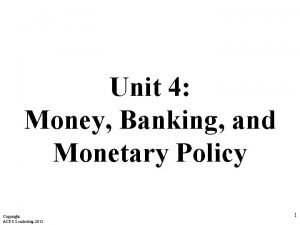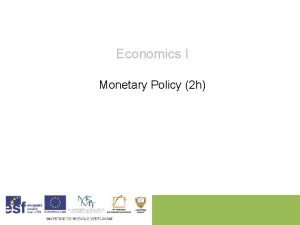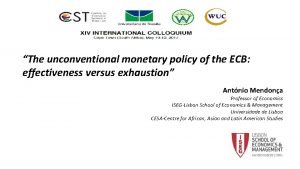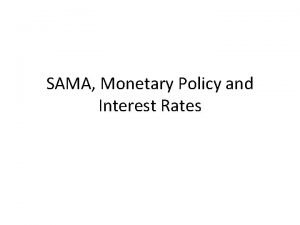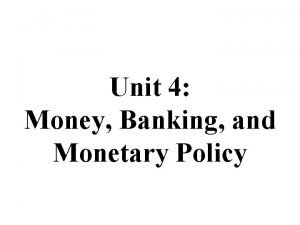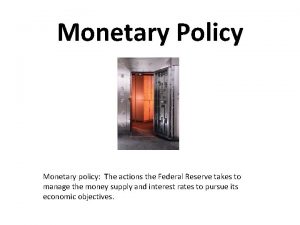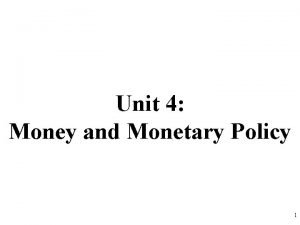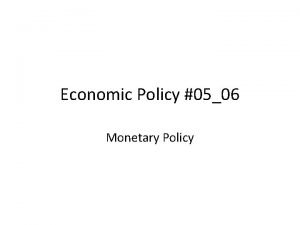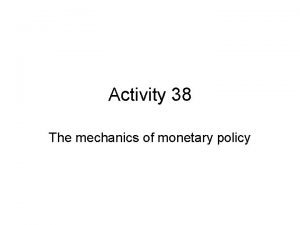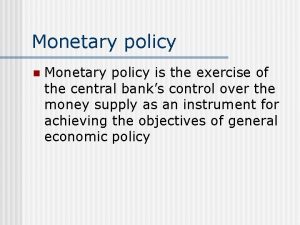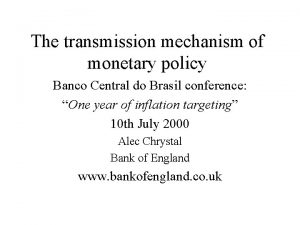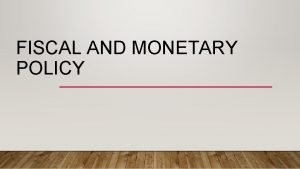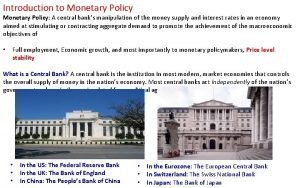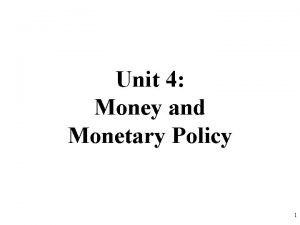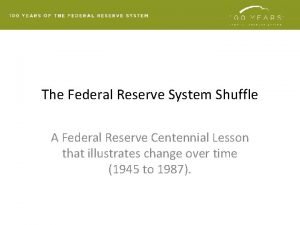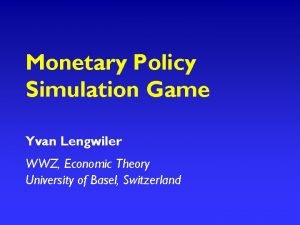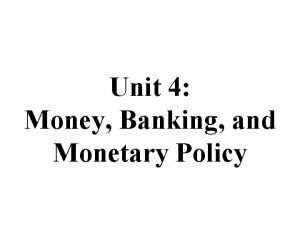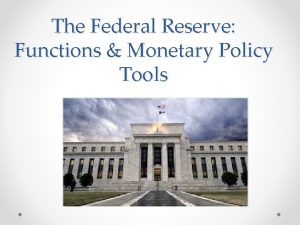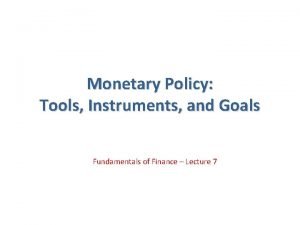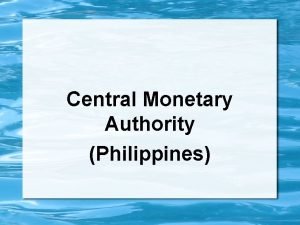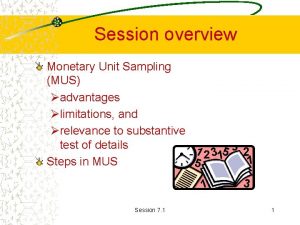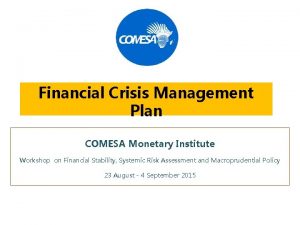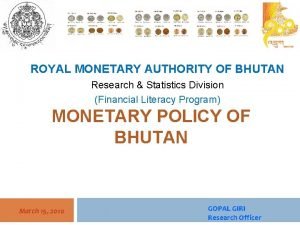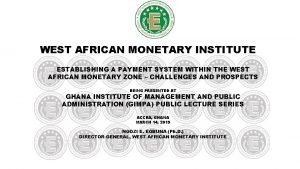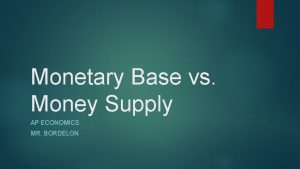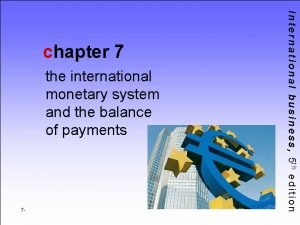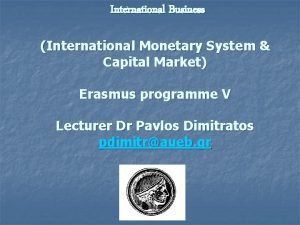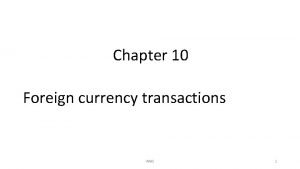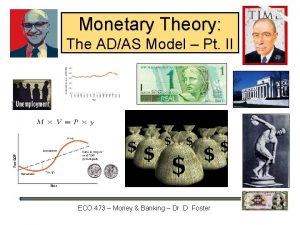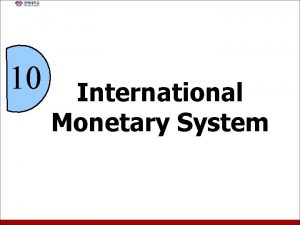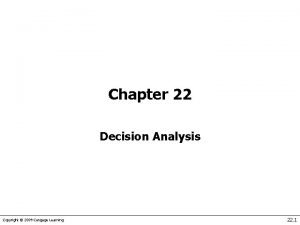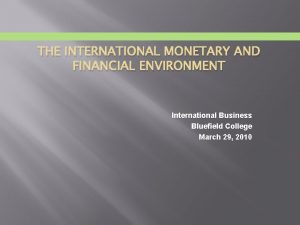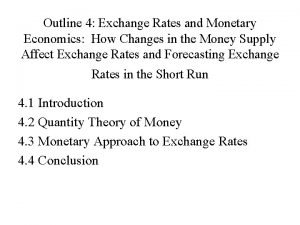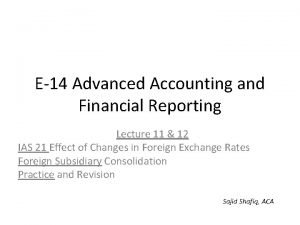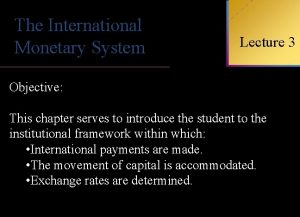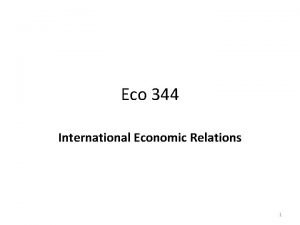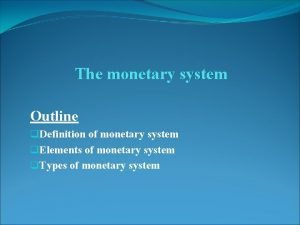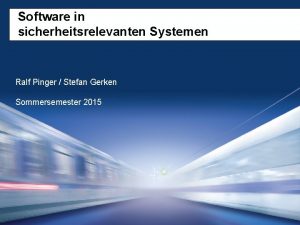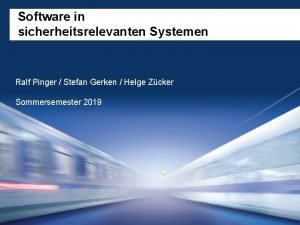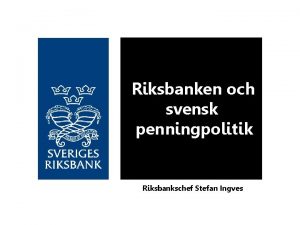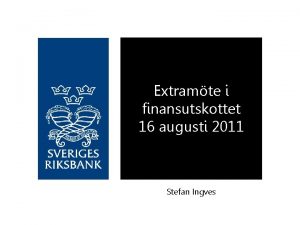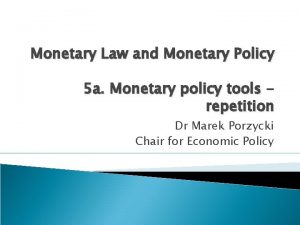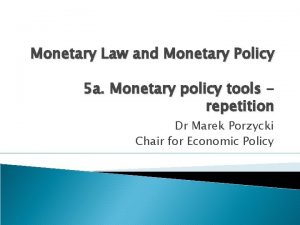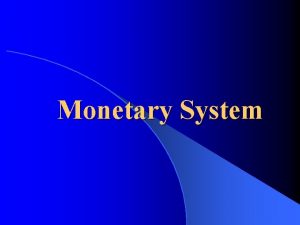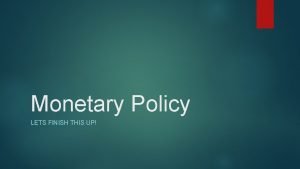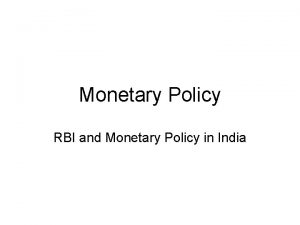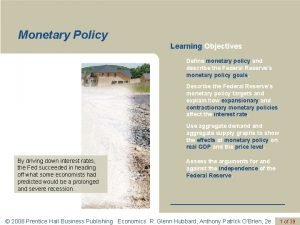Monetary policy Stefan Ingves Monetary policy implementation with















































































- Slides: 79

Monetary policy Stefan Ingves

Monetary policy implementation with inflation target

The world’s oldest central bank 1668 Sveriges Rikes Ständers Bank 1661 Palmstruch first banknotes 1830 s Commercial banks are established 1701 The Riksbank issues “transport” notes 1866 Sveriges Riksbank 1904 Monopoly on issuance of banknotes 1999 New legislation makes bank independent

An authority under the Riksdag The Government Sveriges Riksbank The Ministry of Finance The Swedish National Debt Office Finansinspektionen (the Swedish Financial Supervisory Authority)

Economic policy Fiscal policy Monetary policy The Riksdag and the Government The Riksbank

The Riksbank’s governing The Riksdag General Council 11 members Executive Board 6 members

The executive board of the Riksbank Stefan Ingves Lars Nyberg Svante Öberg Lars E. O. Svensson Karolina Ekholm Barbro Wickman-Parak

The Riksbank’s tasks n To safeguard the value of money (=price stability) - Oversee and analyse monetary stability - Conduct monetary and exchange rate policy measures - Manage the foreign exchange reserve n To promote a safe and efficient payment system - Oversee and analyse stability in the payment system - Responsibility for the RIX system - Ensure the supply of banknotes and coins

CPI-inflation and historical mean Annual percentage change Sources: Statistics Sweden and the Riksbank

Different monetary policy regimes Note. The vertical line marks the date for the shift in monetary policy regime, 19 nov 1992. Source : The Riksbank

An independent Riksbank n Up to 1999: Conducted monetary and exchange rate policy. General Council 4 years Riksbank Governor 5 years n After 1999: Price stability General Council 4 years Executive Board 6 years

The Riksbank’s organisation Executive Board Internal Audit Department Administration Department Financial Stability Department General Secretariat Market Operations Department International Secretariat Monetary Policy Department Research IT Department

Monetary policy theory Why a price stability target? n Monetary policy can not affect employment in the long run n Establishing inflation expectations n High and fluctuating inflation increases uncertainty and affects investment n Costly to hold back inflation n High inflation leads to redistribution of income and wealth n One instrument – one target

Inflation expectations by money market agents Per cent Sources: Statistics Sweden and Prospera Research AB

Why one to two years ahead ? n Uncertainty over the transmission mechanism n Reduce fluctuations in the real economy

Forecasts 6 monetary policy meetings per year (2008) - 3 Monetary Policy Reports - 3 updated assessments - 2 public hearings before the Riksdag Committee on Finance n

Repo rate with uncertainty bands Per cent, quarterly averages Note. Broken lines represent the Riksbank’s forecast. Sources: The Riksbank

CPI with uncertainty bands Annual percentage change Note: Broken line is the Riksbank’s forecast Source : Statistics Sweden and the Riksbank

GDP with uncertainty bands Annual percentage change, seasonally-adjusted data Note. Broken lines represent the Riksbank’s forecast. Sources: Statistics Sweden and the Riksbank

Optimal monetary policy n Within a theoretical framework: Minimize quadratic forecast loss function = , mean inflation forecast at t for period mean output gap forecast, constant relative weight on output-gap stabilization 20

Modified Taylor curves (ex-ante) and optimal monetary policy choice D A B C E 0 21

Estimated inflation and GDP gap Percentage deviation from the target and HP trend Note. Broken lines represent the Riksbank’s forecast. Sources: Statistics Sweden and the Riksbank

Production as a Cobb-Douglas function and A = Technology, K = Capital , H = Hours worked, = average hours per worker L = Labour and α = constant 23

Estimated gaps Percentage deviation from the HP trend Note. Broken lines represent the Riksbank’s forecast. Sources: Statistics Sweden and the Riksbank

Signalling – influencing expectations n Monetary Policy Reports n Policy rates and policy rate forecasts n Minutes of monetary policy meetings n Speeches – clearifying standpoints afterwards, signalling in advance just in exceptional cases

Signalling - Policy rate and 3 month treasury bills Procent Source : The Riksbank

Summary n n n The Riksbank is an authority under the Riksdag Reasonably low inflation is beneficial (target of 2% +-1%) Repo rate change achieves full impact after 1 -2 years Independent from 1999 Openness => a tool that creates legitimacy

Monetary policy implementation

Monetary policy repo n Repos are implemented weekly n Term of one week Liquidity forecast in the morning n Repo announcement on Tuesdays 09. 30 -09. 45 n Allocation at 10. 00 n Liquidity flow on Wednesday n n n lending/delivery of collateral Daily fine-tuning operations at 16. 20 -16. 40

Policy rates & deposit rates Per cent Source : The Riksbank

The overnight market In both examples Bank A and B have two possibilities. 1) They can use the overnight market or 2) They can use the standing facilities offered by the Riksbank The Riksbank O/n interest rate Example 1 Bank A + 50 2. 75 Bank B - 50 1. 25 The position of the banking system 0 The Riksbank O/n interest rate Example 2 2. 75 Bank A -+100 Bank B - 50 1. 25 0 The position of the banking system

The overnight market – MPU April-09 In both examples Bank A and B have two possibilities. 1) They can use the overnight market or 2) They can use the standing facilities offered by the Riksbank The Riksbank O/n interest rate Example 1 Bank A + 50 0. 50 Bank B - 50 0. 00 The position of the banking system 0 The Riksbank O/n interest rate Example 2 0. 50 Bank A -+100 Bank B - 50 0. 00 0 The position of the banking system

Carrying out the main refinancing operation n Calculating the net position of the banking system n n n n Banknotes and coins in circulation +Deposit facility +Other liabilities +Capital. /. Gold and foreign exchange reserve. /. Marginal lending facility. /. Other assets =Net position of the banking system, i. e. the level of the repooperation or issuing of certificates

Schedule for the main refinancing operation

The Riksbank steering of the O/N Rate Over Night Interest Rate, % Lending Facility (ceiling) Fine tuning Operations +/- 10 bp (1. 25%) (2. 75%) Repo Rate (2. 00) and O/N Rate are within the corridor Deposit Facility (Floor) Liquidity surplus 0 Liquidity deficit The position of the banking system, i. e the need for the banks to deposit at or borrow from the Riksbank The Riksbank is carrying out a repo transaction and the liquidity need of the banking system is placed close to zero

The Riksbank steering of the O/N Rate – MPU April-09 Over Night Interest Rate, % Lending Facility (ceiling) Fine tuning Operations +/- 10 bp (0. 00%) (0. 50%) Repo Rate (0. 50) and O/N Rate are within the corridor Deposit Facility (Floor) Liquidity surplus 0 Liquidity deficit The position of the banking system, i. e the need for the banks to deposit at or borrow from the Riksbank The Riksbank is carrying out a repo transaction and the liquidity need of the banking system is placed close to zero

Changes in the yield curve when the policy rate is altered

To sum up The banking system has always the possibility to deposit or borrow over night at predefined interest rates, thus the overnight interest rate will be between these two interest rates. n In order to stabilise the short term interest rate we carry out different monetary policy operations, above all a weekly repo operation and daily fine tuning. n

Monetary Policy Repo n n n Weekly Repo transaction n One week maturity Liquidity forecast in the morning Repo announcement / bids on Tuesdays between 9. 30 -9. 45 Allotment at 10. 00 Settlement on Wednesday n Loan/delivery of securities

Example : Repo operation (cont) Terms and conditions published on Reuters, tuesdays at 09. 30 REPO 070214 -070221 FIXED REPO RATE 3. 00 %. ON FEBRUARY 14 2007, THE RIKSBANK SHALL PURCHASE GOVERNMENT SECURITIES AND OTHER VALID SECURITIES FOR RESALE ON FEBRUARY 21 2007. ALL MONETARY POLICY COUNTERPARTIES ARE INVITED TO SUBMIT BIDS TO THE RIKSBANK (08 -6966970) BY 9. 45 AM ON FEBRUARY 13 2007, AT THE LATEST. THE LOWEST ACCEPTED VOLUME IS SEK 200 MLN. THE HIGHEST ACCEPTED VOLUME IS SEK 5 BLN.

Example: Repo operation Bidding takes place between 09. 30 -09. 45 n Bank A bids 3 billion SEK Bank B bids 2 billion SEK Bank C bids 2 billion SEK Total bids = 7 billion SEK n Riksbank has forecasted the aggregated liquidity deficit of the banking system to 4 billion SEK on average during the repo period. n The allotment will therefore be 4 billion/7 billion = 0, 5714 = 57, 14 per cent n

Example : Repo operation (cont) Bank A receives 57, 14 % of bidding volume. 0, 5714 x 3 billion = 1 714 billion SEK n Bank B receives 57, 14 % of bidding volume. 0, 5714 x 2 billion = 1 143 billion SEK n Bank C receives 57, 14 % of bidding volume. 0, 5714 x 2 billion = 1 143 billion SEK n Total amount allocated: 1 714 + 1 143 = 4 000 SEK billion

Example : Repo operation (cont) Result of repo operation published on Reuters at 10. 00 RESULT OF FIXED REPO 070207 -070214 FIXED REPO RATE 3. 00 % ACCEPTED VOLUME 4. 0 billion PERCENTAGE ALLOTTED 57. 1400 % DEPOSIT RATE 2. 25 % LENDING RATE 3. 75 %

The monetary policy landscape in a financial crisis


The macroeconomic landscape n The financial landscape n Regulatory landscape n

The inflation target n Stability in the payment system n

Background to the crisis: The macroeconomic landscape n Global imbalances built up over a longer period of time n n n Large current account surplus in the east Large current account deficit in the west Large capital flows and expansionary monetary policy pushed down interest rates

Current account as share of GDP Per cent Source : The IMF

Background to the crisis: The financial landscape n Low interest rates led to hunt for investment with higher return n Increased indebtedness Sharp increase in asset prices Extremely low risk premiums Securitisation and many new instruments n Special companies off the banks’ balance sheets n n Implicit and explicit guarantees led risks back into the banks

Credit spreads* for corporate bonds in the USA basis points *)Difference between corporate bond rate and government bond rate, source Reuters Eco. Win

Background to the crisis: The financial landscape (cont. ) n n n A complicated structure that was difficult to gain insight into Much uncertainty over where risks lay Fears caused trade to fade away on many markets Many banks experienced difficulty refinancing themselves When Lehman Brothers fell Swedish banks were also indirectly drawn into the crisis

Background to the crisis: The financial landscape (cont. ) n Fundamental failures in risk management n n The banks’ incentives to monitor credit risks partly disappeared The credit rating agencies’ models were inadequate and credit ratings were used wrongly. n n Correlations were underestimated Liquidity risks were underestimated Risks were priced incorrectly Fundamental flaws in corporate governance

Background to the crisis: the Regulatory landscape n Gaps in the regulatory framework enabled regulation arbitrage n n n Investment banks OTC derivatives Banks could expand off balance sheet Too little focus on liquidity risks n Insufficient links between supervision and macro factors and systemic risk factors respectively n Too strong national focus in financial supervision n

Massive and unusual measures by authorities n Large increase in lending by central banks n n n Longer maturities, different collateral Special liquidity assistance to individual institutions Agreements on currency loans between countries Extended deposit guarantee Programme for guarantees and capital injections Large policy rate cuts

How monetary policy normally functions n The transmission mechanism

The transmission mechanism Interest rate channel n Credit channel n Exchange rate channel n Inflation expectations n n Financial markets are not functioning normally => transmission mechanism becomes less effectives

Monetary policy and financial stability n The Riksbank has two main tasks: Monetary policy and financial stability n Normally separate tools are used for these tasks n During the crisis it has become increasingly clear how closely interwoven the two tasks are. Monetary policy Financial stability n. Policy netc. rate n”Moral suasion” n. Inject liquidity netc.

Monetary policy and financial stability are interlinked:

Monetary policy in a financial crisis Interest rates close to zero in many countries n When the traditional monetary policy tools are no longer effective it is necessary to find new ways n ”Unconventional methods” n n n Different ways of making the financial markets function better Improve the supply of credit

Unconventional monetary policy A stylised balance sheet for a central bank Assets Liabilities Foreign assets Banknotes and coins Domestic assets Bank deposits Lending Equity

Central banks’ balance sheets Percentage of GDP Sources: Bureau of Economic Analysis, Eurostat , Office for National Statistics, Statistics Sweden and the respective central banks

The Riksbank’s balance sheet on 30 June 2008 (prior to Lehman Brothers crash) Assets Gold Foreign currency reserve Lending USD Liabilities 26 Banknotes & coins 158 Fine-tuning 108 0 0 Riksbank Certificates 0 Lending SEK 4 Liabilities to Fed 0 Other 4 Equity 59 Other 25 TOTAL 192

The Riksbank’s balance sheet on 31 Dec 2008 (after Lehman Brothers crash) Assets Gold Foreign currency reserve Lending USD Lending SEK Other TOTAL Liabilities 30 Banknotes & coins 200 Fine-tuning 196 Riksbank Certificates 262 Liabilities to Fed 112 207 49 189 7 Equity 59 Other 84 700 TOTAL 700

Monetary policy measures The banks’ access to means of payment is increasing n The monetary base (the banks’ reserves + banknotes and coins in circulation) is increasing n The Federal Reserve and the Bank of England have gone a step further than the RB and bought different types of domestic financial assets n

Monetary base SEK billion Source : The Riksbank

Credit easing Federal Reserve: n Purchase of certain private financial assets n Aimed at n n n reducing risk spreads making it easier for companies and households to gain access to credit Focus on the asset side of the balance sheet

Quantitative easing Bank of England: n Purchase of government securities n Focus on the liabilities side of the balance sheet n Instead of the price, i. e. the policy rate, the quantity of the banks’ borrowing, the monetary base, is affected directly

Quantity equation :

Unconventional measures Both Quantitative Easing and Credit Easing are only used under special circumstances n The situation is new for most central banks n It may be wise to exercise a good portion of humility with regard to what these measures entail n

Are similar measures needed in Sweden? We do not know yet n Inflation expectations and the credibility of the inflation target are crucial n The Riksbank’s established monetary policy framework is a strength n The Riksbank does what is necessary, when it is necessary n

How do we prevent crises in the future ? By bursting bubbles with interest rate policy? n Difficult and important question, but not easy to reach a general conclusion n In one way or another, substantial increases in asset prices will affect monetary policy in the future n However, probably more important to have suitable rules and supervisory functions for financial companies

How do we prevent crises in the future ? Financial supervisionfunctions? National level: n Important to have coordination between the Riksbank and Finansinspektionen (Swedish financial supervisory authority) International level – de Larosiére group: n European Systemic Risk Council (27 central banks + ECB) monitoring systemic risks n Supervisory committees in Europe strengthened n A step in the right direction – and not a day too soon!

How do we prevent crises in the future ? A Taylor rule for capital adequacy? Knut Wicksell (1898):

The Taylor rule for monetary policy

A ”Taylor rule” for capital adequacy

The link between monetary policy and financial stability

Concluding reflections Financial crises are nothing new n The scope and complexity of this crisis makes it more serious than previous crises n Deglobalisation in the wake of the crisis is worrying n We must find tools to attain a more balanced development in the future n

How do we ensure that confidence is restored ? n The international banking system requires a purge n n All problems must be brought to light Only when we see the scope of the losses can confidence be restored This is a more difficult process than during the Swedish bank crisis of the 1990 s Meanwhile the Riksbank is prepared to do whatever is necessary!
 Unit 4 money and monetary policy
Unit 4 money and monetary policy What are the objectives of monetary policy
What are the objectives of monetary policy Ecb unconventional monetary policy
Ecb unconventional monetary policy Tools of monetary policy ppt
Tools of monetary policy ppt Unit 4 money banking and monetary policy
Unit 4 money banking and monetary policy Monetary policy summary
Monetary policy summary Expansionary money policy
Expansionary money policy What is the meaning of monetary policy
What is the meaning of monetary policy Cost-push inflation
Cost-push inflation Unit 4 money and monetary policy
Unit 4 money and monetary policy What are the objectives of monetary policy
What are the objectives of monetary policy Monetary policy baseline
Monetary policy baseline Instruments of monetary policy
Instruments of monetary policy Transmission mechanism
Transmission mechanism Fiscal vs monetary policy
Fiscal vs monetary policy Monetary policy types
Monetary policy types Expansionary money policy examples tagalog
Expansionary money policy examples tagalog Moral suasion by central bank
Moral suasion by central bank Unit 4 money and monetary policy
Unit 4 money and monetary policy Contractionary monetary policies
Contractionary monetary policies Expansionary monetary policy flow chart
Expansionary monetary policy flow chart Lesson quiz 16-1 monetary policy
Lesson quiz 16-1 monetary policy Types of monetary policy
Types of monetary policy Monetary policy simulation game
Monetary policy simulation game Macroeconomics lesson 2 activity 45
Macroeconomics lesson 2 activity 45 Features of fiscal policy ppt
Features of fiscal policy ppt Unit 4 money banking and monetary policy
Unit 4 money banking and monetary policy Monetary policy
Monetary policy Three tools of monetary policy
Three tools of monetary policy Expansionary policy
Expansionary policy Meaning of monetary
Meaning of monetary Instruments of monetary policy
Instruments of monetary policy Public policy stages
Public policy stages Top ten risk item tracking
Top ten risk item tracking Central monetary authority
Central monetary authority Non monetary assets
Non monetary assets What are the open market operations
What are the open market operations International monetary fund
International monetary fund Azure monetary commitment
Azure monetary commitment Monetary flow
Monetary flow Mus sample
Mus sample Comesa monetary institute
Comesa monetary institute Functions of royal monetary authority of bhutan
Functions of royal monetary authority of bhutan West african monetary institute
West african monetary institute Monetary base ap macro
Monetary base ap macro International monetary system
International monetary system International monetary system
International monetary system International monetary fund apush
International monetary fund apush Chapter 29 the monetary system
Chapter 29 the monetary system Monetary assest
Monetary assest Non-monetary rewards
Non-monetary rewards International monetary and financial environment
International monetary and financial environment Monetary
Monetary Example of non monetary items
Example of non monetary items International monetary fund
International monetary fund Objectives of international monetary system
Objectives of international monetary system How to calculate expected value with perfect information
How to calculate expected value with perfect information Money neutrality
Money neutrality What is a monetary asset
What is a monetary asset International monetary and financial environment
International monetary and financial environment Monetary model
Monetary model Monetary award program
Monetary award program Consolidation accounting
Consolidation accounting International monetary system
International monetary system Monetary model
Monetary model Monetary system definition
Monetary system definition Joseph stefan
Joseph stefan Stefan kvarnerås
Stefan kvarnerås Stefan
Stefan Stefan gerken
Stefan gerken Stefan gerken
Stefan gerken Ciekawostki o kardynale stefanie wyszyńskim
Ciekawostki o kardynale stefanie wyszyńskim Stefan ciobaca
Stefan ciobaca Martin isenburg
Martin isenburg Stefan stamenkovski
Stefan stamenkovski Stefan talke
Stefan talke Stefan ritt
Stefan ritt Stefan parrisius katrin müller hohenstein
Stefan parrisius katrin müller hohenstein Stefan savage
Stefan savage Stefan roest
Stefan roest
